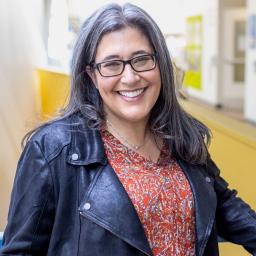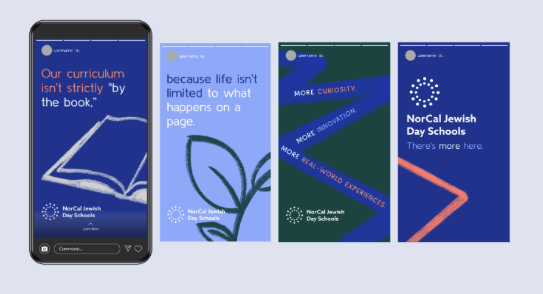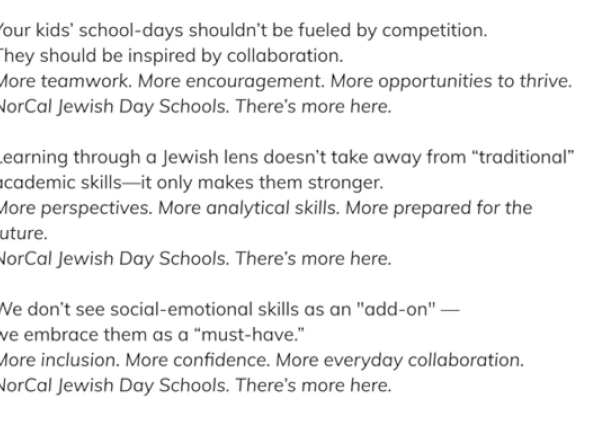"What we want in our Jewish day schools is for people to see that people are far less concerned with what I’m doing wrong Jewishly than with what I’m doing right and with what is compelling and meaningful to me as a human being in the world. Marketing and branding are ways for us to get past some of those hurdles. People can realize that day schools provide a way for you to share something profound with your children that doesn’t have to be about feeling not part of something because you felt like there was a right way to do Jewish and you weren’t part of that.” - Dr. Dan Glass, Head of School, The Brandeis School of San Francisco.
Our twelve day schools in Northern California are used to working together. The heads of school have met regularly for decades, exponentially more so in the pandemic. We have created joint professional development days, shared sports programs for students, and more. When The Jewish Community Federation and Endowment Fund (of the Bay Area) issued a call for pandemic recovery grants rooted in collaboration, we saw the marketing and branding of our schools—after a pandemic-related enrollment surge—as a valuable area for experimentation.
This initiative was buoyed by a research project supported by the Jim Joseph Foundation and conducted by Third Plateau, which found that for their particular target families, some of our schools are too Jewish; for others, not rigorous enough; and according to a different segment, not Jewish enough. We know, of course, that there are places in our schools for those not otherwise Jewishly engaged, for interfaith and dual-faith couples and families, for those looking for advanced science and math or Talmud. We know that we seek out innovative curricula, environments of curiosity and growth for our teachers, and audaciously hospitable communities that support and welcome all families. How could we tell those stories?
Working together, nine of our schools—mostly K-8 or K-6, with a few preschools or pre-kindergarten programs and one stand-alone high school —built an RFP, employed a full-service branding and marketing firm (MediaCause), and put together a project to tell a new day school story in Northern California. With the firm, we:
- Conducted research with families who chose our schools despite deep uncertainty and reservations, or who, more generally, represented the audience we were targeting for growth.
- Built a full branding campaign rooted int he idea that “There’s More Here”; There’s more community, there’s more curriculum, there’s more learning, there’s more growth (a few of the 20 taglines the firm developed and shared below).
- Built a shared website, a landing page, with data on our schools and links to admissions pages.
- Ran a social media and internet ad campaign during October-November, targeting a list identified with their search choices and zip code, and then flipped that campaign to a school-related campaign, sharing open houses with those who saw the first ads.
- Sent a series of emails to those who saw the first ads, sharing school-specific information.
In the end, we reached 12 million people with impressions and other e-connections. And we learned important lessons about messaging, marketing, and working together.





